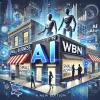
By Elke Porter | WBN Ai | June 16, 2025
Subscription to WBN and being a Writer is FREE!
In the ever-evolving landscape of digital marketing and search, the emergence of Answer Engines—AI-powered tools like ChatGPT, Perplexity, and Google’s Search Generative Experience (SGE)—signals a fundamental shift in how people seek and receive information. This transition from keyword-based searches to direct answers marks the rise of Answer Engine Optimization (AEO), a strategic approach that challenges the dominance of traditional SEO and hashtag-driven visibility.
From Search to Answer: What Is an Answer Engine?
Answer Engines are tools powered by artificial intelligence that deliver precise, conversational, and context-aware responses to user queries. Unlike traditional search engines that return a list of links, these systems aim to provide direct, comprehensive answers—cutting the need to browse multiple sources. This marks a dramatic shift from the way we've used search engines for the past two decades.
Platforms like OpenAI’s ChatGPT, You.com, Perplexity.ai, and even Google's own Gemini are moving toward becoming not just portals to content, but the content itself.
Why Traditional SEO and Hashtags Are Losing Ground
Search Engine Optimization (SEO) and hashtags have long been the gold standard for visibility. Brands and creators spent years crafting keyword-rich articles, optimized headlines, and strategic hashtag groupings to climb the ranks of Google or trend on platforms like Instagram or Twitter (now X).
However, these strategies rely on human-driven inputs (search queries and discovery habits), while Answer Engines bypass this step by understanding intent and delivering contextually accurate results, sometimes without even linking back to the source.
That means even perfectly SEO-optimized content may be summarized or paraphrased by AI, reducing the chances that a user will click through to the original page.
Enter Answer Engine Optimization (AEO)
To adapt, content creators are now turning to AEO—Answer Engine Optimization. AEO involves:
- Structuring content with clear questions and answers (think FAQs and How-To formats)
- Using natural language, not just keywords
- Prioritizing expertise, experience, authority, and trustworthiness (E-E-A-T)
- Adding structured data and schema markup for easier AI indexing
- Creating high-quality, concise content that can easily be cited or summarized by AI tools
Rather than stuffing a post with keywords or trendy hashtags, AEO emphasizes intent and clarity, ensuring that AI engines understand and elevate your content in response to a user’s question.
AEO vs SEO vs Hashtags: A Snapshot
| Strategy | Strengths | Limitations |
|---|---|---|
| SEO | Works with traditional search engines | May not surface in AI summaries |
| Hashtags | Great for social media discoverability | Limited to platforms and trends |
| AEO | AI-friendly and conversational | Requires a deeper understanding of intent |
TAGS: Answer Engine #AEO #Digital Marketing Trends #Future Of Search #AI Content Strategy #SEO vs AEO #WBN AI Edition #Elke Porter
Connect with Elke at Westcoast German Media or on LinkedIn: Elke Porter or contact her on WhatsApp: +1 604 828 8788


